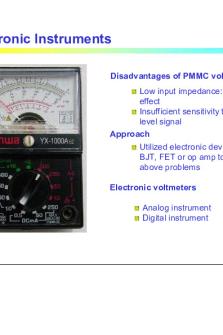Restriking voltage and recovery voltage PDF

| Title | Restriking voltage and recovery voltage |
|---|---|
| Course | Protection and Switchgear |
| Institution | PES University |
| Pages | 3 |
| File Size | 126.4 KB |
| File Type | |
| Total Downloads | 47 |
| Total Views | 169 |
Summary
Prof. Shivani...
Description
Restriking voltage and recovery voltage It is the transient voltage that appears across the contacts at or near current zero during arcing period.If dielectric strength rise is greater than the rise of restriking voltage then the arc will not restrike.
RestrikingVoltage : it is the transient voltage that exists during the arcing time. ( natural frequency kHz ).
Recovery Voltage : it is the rms voltage after final arc extinction. ( normal frequency 50 or 60 Hz). both voltages appear between circuit breaker poles. A circuit breaker is a piece of equipment which can Make or break a circuit either manually or by remote control under normal conditions.
Break a circuit automatically under fault condition
Make a circuit either manually or by remote under fault condition
Circuit Breaker consists of fixed and moving contacts called electrodes Under normal operating condition these contacts remain closed and will not open automatically unless the system becomes faulty .These contacts can be opened manually or by remote control. When a fault occurs in a circuit the trip coils of the circuit breaker get energized and the moving contacts are pulled apart by some mechanism ,thus opening the circuit.
Rate of rise of recovery voltage It is the rate of increase of restriking voltage and is abbreviated by R.R.R.V. its unit is kV/m sec.Consider the fig2 below showing the opening of circuit breaker under fault conditions. Before current interruption, the capacitance C is short circuited by the fault and the short circuit current through the breaker is limited by inductance L of the system The short circuit current will lag the voltage by 90° where i represents the short circuit current and ea represents the arc voltage. Under short circuit condition the entire generator voltage appears across inductance L. when the contacts are opened and the arc finally extinguishes at some current zero, the generator voltage e is suddenly applied to the inductance and capacitance in series. This L-C combination forms an oscillatory circuit produces a transient of frequency;fn= 1/ [ 2π(LC)1/2] , which appears across the capacitor and hence across the contacts of the circuit breaker. This transient voltage is known as restriking voltage and may reach an instantaneous peak value twice the peak phase neutral voltage i.e. 2 Em. It is R.R.R.V, which decides whether the arc will re-strike. If R.R.R.V is greater than the rate of rise of dielectric strength between the contacts, the arc will re-strike. The arc will fail to re-strike if R.R.R.V is less than the rate of increase of dielectric strength between the contacts of the breaker. The value of R.R.R.V depends on:
Recovery voltage
Natural frequency of oscillations...
Similar Free PDFs

Voltage regulators
- 26 Pages

Dynamic Voltage Restoration
- 5 Pages

High Voltage Engineering
- 213 Pages

Combining Voltage Sources
- 5 Pages

Stator Voltage Control
- 4 Pages

Voltage Bandgap Reference
- 19 Pages

High-Voltage Engineering
- 547 Pages

High Voltage engineering CL Wadhwa (1)
- 312 Pages
Popular Institutions
- Tinajero National High School - Annex
- Politeknik Caltex Riau
- Yokohama City University
- SGT University
- University of Al-Qadisiyah
- Divine Word College of Vigan
- Techniek College Rotterdam
- Universidade de Santiago
- Universiti Teknologi MARA Cawangan Johor Kampus Pasir Gudang
- Poltekkes Kemenkes Yogyakarta
- Baguio City National High School
- Colegio san marcos
- preparatoria uno
- Centro de Bachillerato Tecnológico Industrial y de Servicios No. 107
- Dalian Maritime University
- Quang Trung Secondary School
- Colegio Tecnológico en Informática
- Corporación Regional de Educación Superior
- Grupo CEDVA
- Dar Al Uloom University
- Centro de Estudios Preuniversitarios de la Universidad Nacional de Ingeniería
- 上智大学
- Aakash International School, Nuna Majara
- San Felipe Neri Catholic School
- Kang Chiao International School - New Taipei City
- Misamis Occidental National High School
- Institución Educativa Escuela Normal Juan Ladrilleros
- Kolehiyo ng Pantukan
- Batanes State College
- Instituto Continental
- Sekolah Menengah Kejuruan Kesehatan Kaltara (Tarakan)
- Colegio de La Inmaculada Concepcion - Cebu







